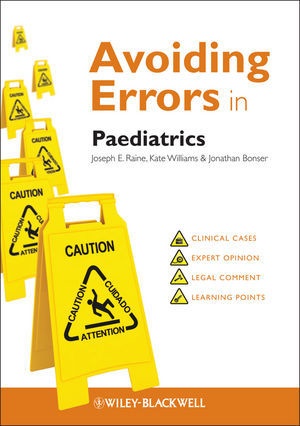Read more
Informationen zum Autor Joseph E. Raine is Consultant Paediatrician, Whittington Hospital, London Kate Williams is Partner, RadcliffesLeBrasseur Solicitors, Leeds Jonathan Bonser is Consultant in the Healthcare Department of Fishburns LLP, Solicitors, London, and former Head of the Claims and Legal Services, Department of the Leeds office of the Medical Protection Society Klappentext Some of the most important and best lessons in a doctor's career are learnt from mistakes. However, an awareness of the common causes of medical errors and developing positive behaviours can reduce the risk of mistakes and litigation.Written for junior paediatric staff and consultants, and unlike any other paediatric clinical management title available, Avoiding Errors in Paediatrics identifies and explains the most common errors likely to occur in a paediatric setting - so that you won't make them.The first section in this brand new guide discusses the causes of errors in paediatrics. The second and largest section consists of case scenarios and includes expert and legal comment as well as clinical teaching points and strategies to help you engage in safer practice throughout your career. The final section discusses how to deal with complaints and the subsequent potential medico-legal consequences, helping to reduce your anxiety when dealing with the consequences of an error.Invaluable during the Foundation Years, Specialty Training and for Consultants, Avoiding Errors in Paediatrics is the perfect guide to help tackle the professional and emotional challenges of life as a paediatrician. Zusammenfassung For Junior Doctors, Specialty Trainees, and all those involved in hospital governance, this book offers the ultimate real-life guide to help tackle the professional and emotional challenges of life as a doctor in paediatrics. Unlike other clinical management titles, this book identifies and explains the most common and important medical errors. Inhaltsverzeichnis Contributors, viii Foreword, ix Abbreviations, xi Introduction, xiii Part 1 Section 1: Errors and their causes A few words about error, 1 Learning from system failures - the vincristine case, 1 Person-centred paediatric errors and their causes, 8 The patient consultation, 10 Failure to identify a sick child, 12 Inability to perform practical procedures competently, 13 Failure to check test results or act on abnormal findings, 15 Prescribing errors, 16 Failures in resuscitation, 17 Sources of error in child protection cases, 19 References and further reading, 22 Section 2: Medico-legal aspects Error in a legal context, 25 Negligence, 25 Medical negligence, 26 Issues around consent, 29 Confidentiality, 34 References and further reading, 37 Part 2 Clinical cases Introduction, 39 Case 1 A boy with a limp, 40 Case 2 A fitting infant, 43 Case 3 A persistent fever, 45 Case 4 A biking injury, 48 Case 5 A teenager with abdominal pain, 51 Case 6 A young girl with a vaginal discharge, 54 Case 7 An iatrogenic problem, 57 Case 8 An infant with a large head, 59 Case 9 An infant with bloody diarrhoea, 62 Case 10 An infant with persistent jaundice, 64 Case 11 A child with leukaemia and tummy ache, 66 Case 12 A boy with fever and rigors, 68 Case 13 A stiff hand, 70 Case 14 A serious feeding problem, 72 Case 15 Fits, faints and funny turns, 74 Case 16 A hospital acquired infection, 76 Case 17 Recurrent wheeze, 79 Case 18 A jaundiced neonate, 82 Case 19 A febrile boy with a limp, 85 Case 20 A febrile neonate, 87 Case 21 A neonate with abnormal movements, 89 Case 22 A teen...

